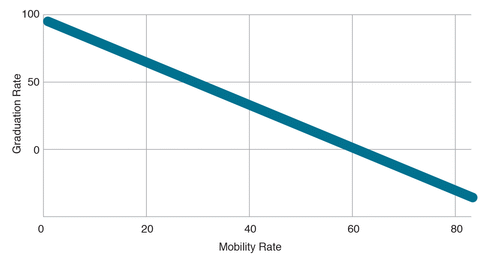Here’s One Way Michigan Miscalculates High School Graduation Rates
By Remy MacDonald, Jessica Shopoff, and Ben DeGrow
Most people understand the advantages of earning a high school diploma. But the way Michigan and most states measure how many students graduate can mislead people about how well a particular school is doing to help students meet this goal.
As a result, schools can be punished despite helping someone like Julia Hewitt learn and succeed. Due to health issues, Julia fell behind in earning high school credits. As she said, “I had missed nearly all of my freshman year and was no longer on track to graduate with the rest of my class. The public school I attended was ultimately not able to meet my needs, so I started exploring other options.”
Julia turned to Insight School of Michigan, an online charter school. Despite lacking enough credits to graduate with her cohort in 2017, Julia persisted. She tested out of several courses and worked hard to make up her missing credits. Earlier this year, she walked across the stage as an Insight graduate, with plans to attend college and pursue her love of filmmaking.
High schools are usually judged by their four-year cohort graduation rates. Groups like the union-funded National Education Policy Center have used the data to attack online charter schools for having a poor record. Yet this measurement unfairly gauges the record of schools that take in many students who need a second chance.
The four-year cohort graduation rate is calculated by tracking each group of incoming ninth-grade students and determining what percentage of them graduate from high school four years later. The last school to enroll the student is the only one for which the student counts as either a graduate or a dropout.
Another metric used by education officials, however, is key to understanding the problem: school mobility rates. In Michigan, a mobile student is defined as one who was enrolled in a school during the fall count day but not for the whole year. A school serving many students who are not enrolled all year has a high mobility rate.
That kind of school is more likely to have a low four-year cohort graduation rate. This is true not only because many students move into the cohort throughout the year, but also because many of these students arrive off the pace needed to graduate on time.
A student who starts out behind at a new school is far less likely to graduate on time. Julia’s original high school, where she fell behind in credits, avoided any official blame. But Insight, where she made progress every year and ultimately graduated, was penalized because she did not finish in four years. Thus, a high school serving hundreds of students in Julia’s situation automatically looks like it’s failing.
Michigan Graduation Rate vs. Mobility Rate
The mobility rate (students entering and leaving a district) is associated with a lower graduation rate.
A statistical analysis of all Michigan high schools in 2016-17 confirms that a school with a high mobility rate is significantly more likely to have a lower graduation rate. Our state falls short of providing a true picture of a school’s graduation success. That’s because the official measurement is as likely to show how many students transfer in late as it is to depict how well the school helps students gain ground. This problem is not isolated to Michigan. It exists in several states, including New Jersey, Oregon and Ohio.
Michigan can do several things to change its faulty measurements. First, calculate the “on time” graduation rate only for students who remain enrolled in the same school from grades 9 through 12. Second, split the penalty for dropping out among the different schools that mobile students have attended, and do so on a proportional basis.
Finally, encourage high schools to help students succeed by creating an alternative metric that looks each year at the share of high school students who have completed enough credits to be on track for a diploma. Instead of measuring graduation success in only year four, report and hold schools accountable for student progress toward graduation each year.
It’s important to fairly and accurately measure how well schools get their students to graduate, regardless of where those students begin or end their high school career. An honest picture of performance can only lead to policies that help young people like Julia succeed.
#####
Remy MacDonald is a data analysis intern for the academic policy team at K12, Inc. Jessica Shopoff is the accountability specialist for the same team. Ben DeGrow is the director of education policy at the Mackinac Center for Public Policy, a research and educational institute headquartered in Midland, Michigan. Permission to reprint in whole or in part is hereby granted, provided that the authors and the Mackinac Center are properly cited.
Michigan Capitol Confidential is the news source produced by the Mackinac Center for Public Policy. Michigan Capitol Confidential reports with a free-market news perspective.



 School survey asks high schoolers about sex, drug habits
School survey asks high schoolers about sex, drug habits
 Michigan spends $6.9M advertising 'cost-free' pre-K
Michigan spends $6.9M advertising 'cost-free' pre-K
 Michigan lawmakers, education officials clash over new sex ed draft
Michigan lawmakers, education officials clash over new sex ed draft